
In a previous post (Beyond Begonia grandis: new hardy begonias), I discussed several begonia species and hybrids that have been around for a few years and were already known (or purported) to be fairly hardy. In this post, I'll discuss a new generation of begonias I've discovered to be hardy in my zone 7a/b garden in just the last few years, even though some of them have been around much longer than that!
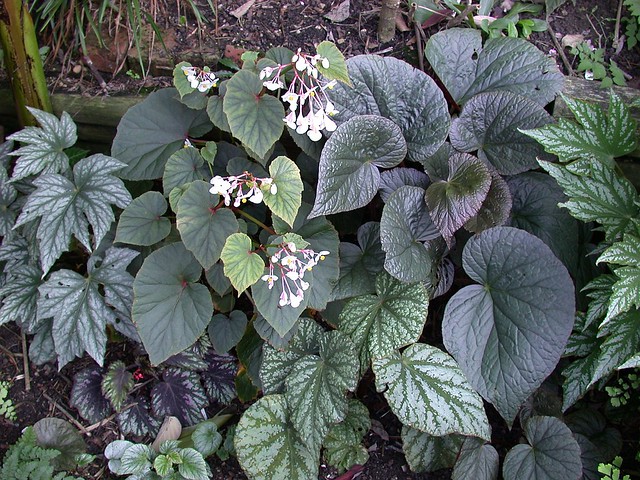
(l-r) B. 'Caribbean Star', B. grandis, B. U508
All the begonias discussed here are either Asian species, or hybrids derived from Asian species, that are closely related to the original "rex begonia", Begonia rex. Most of these have been extremely easy to propagate and grow, and all require approximately the same cultural conditions: bright full shade and rich, well-drained soil that is neither very wet nor very dry. My garden soil is the typical heavy red clay-based soil of my region, but I've been amending it with organic matter for over a decade. Most of these begonias will tolerate a certain degree of drying out, but I water by hand if we go more than a week or so without rain. I've been amazed by the unexpected hardiness of several of these plants, and most have been fairly heat tolerant as well (although I've given up on a few that haven't held up well to my area's brutally hot and humid summers). I've had remarkably few problems with pests or diseases of any kind.
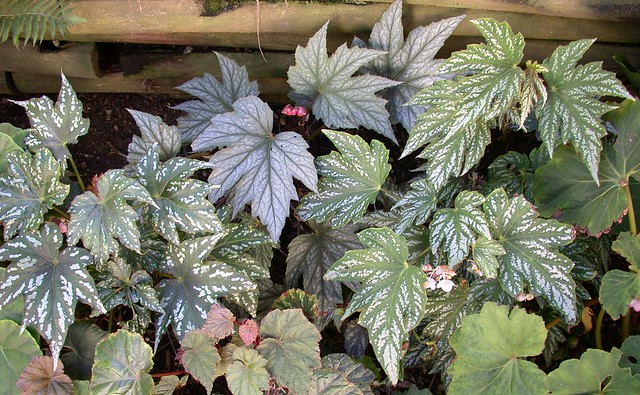
B. deliciosa (left), B. 'Caribbean Star' (center), B. 'Charles Jaros' (right)
Some of these begonias have been around for a while, but some are recent introductions that are still unidentified, as indicated by the "U" numbers assigned by the American Begonia Society (ABS). I've gotten my plants from several different sources. An ABS friend in California shared cuttings of several begonias that had survived a hard freeze in her greenhouse when it lost power one winter. Derick Pitman, who wrote a great article about hardy begonias that helped get me started on this, has been very generous about sharing information as well as cuttings of plants he suspected might be hardy. And finally, I've picked up a few begonias here and there, at plant shows or nurseries, sometimes only on a hunch.
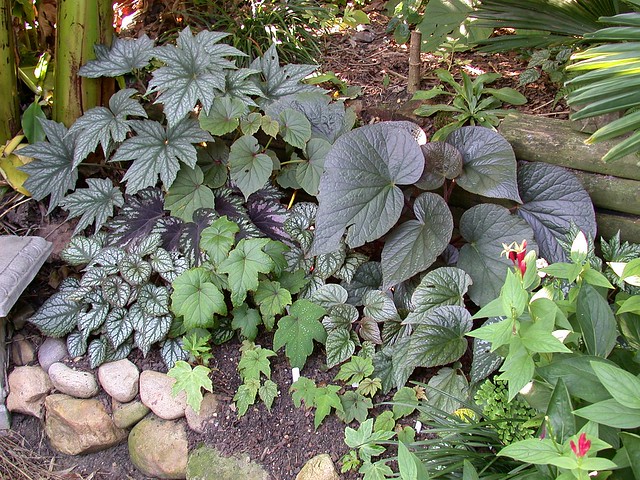
Begonia bed (August 2013)
As previously, I'm limiting this blog post to those begonias that survived the 2013-2014 winter. Although that means only 2 winters in the ground for some of them, last winter was my area's coldest in 20 years so I think it was a pretty good test! All of these survived with only a light mulch for protection (with a few exceptions as noted). They're listed here by approximate order of how long I've had them. After each name, I've indicated how many winters that particular begonia has survived in the ground for me.
Begonia 'Little Brother Montgomery' (4 winters) was suggested as possibly hardy, based on the hardiness of its sibling 'Connee Boswell', by Derick Pitman in his article A Bounty of (Hardier) Begonias. Inspired by Derick's article, I picked up a couple of plants at Pepper's Greenhouses in Milton, Delaware and this has since become one of my favorite begonias. My success with this cultivar has encouraged me to test more begonias for hardiness and it was the subject of one of my first blog posts last year (see Begonia 'Little Brother Montgomery': a star in the fall garden). All I can really add is that my plants have come through yet another winter, their fourth, with minimal protection. Begonia breeder Brad Thompson has produced several beautiful new hybrids using 'Little Brother Montgomery' and all of these merit testing for hardiness.

Begonia 'Little Brother Montgomery'
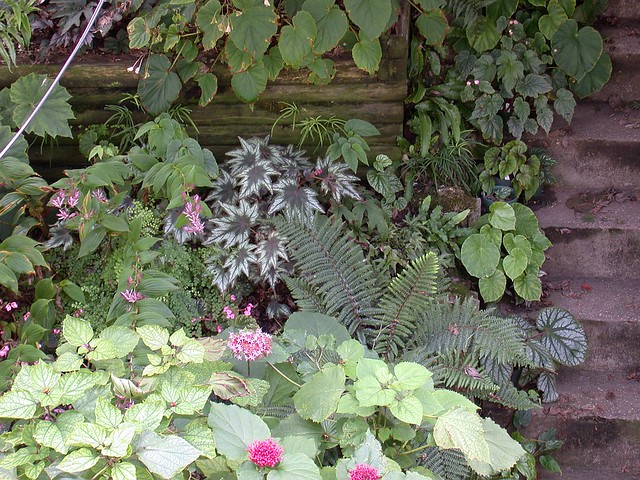
Begonia 'Little Brother Montgomery' stands out in the shade
Begonia U584 (3 winters) was collected on Mt. Omei (Emei Shan) in Sichuan, China in 1998 by Ozzie Johnson. He collected B. pedatifida nearby and it's clearly related to that species, perhaps representing a local variant or a natural hybrid with another species. The two are similar except that U584 has more shallowly lobed leaves that are a dark bronzy green with deep red undersides. The plant grows with a creeping rhizome, forming a gradually spreading clump. The female flowers are very similar to those of B. pedatifida and the two bloom at the same time. The male flowers have always aborted before opening, further suggesting a hybrid origin. The plant requires full shade as the foliage scorches easily in direct sun. Like B. pedatifida and B. emeiensis (and unlike the much hardier B. grandis), U584 comes up very early in the spring. Ozzie has also released 'Red Empress', an open-pollinated seedling of U584 (possibly crossed with B. pedatifida) that is very similar to its mother but larger-growing.

Begonia U584
 Begonia U584 flowers (note red leaf undersides)
Begonia U584 flowers (note red leaf undersides)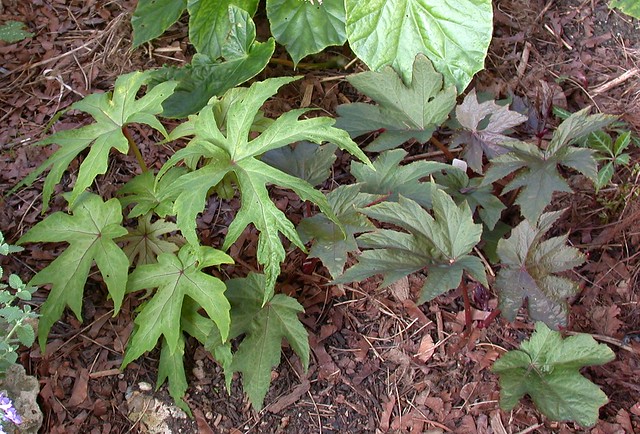
Begonia pedatifida (left) with B. U584 (right)
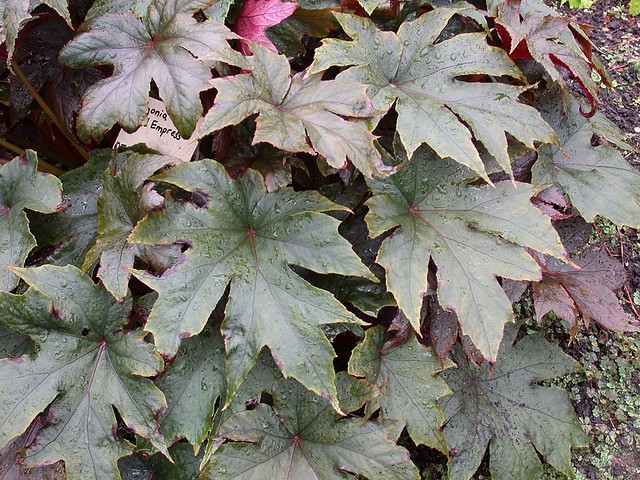
Begonia 'Red Empress' in trial beds at Plant Delights Nursery
Begonia U475 (3 winters) is a dramatic still-unidentified species from China. The large, shallowly lobed leaves are deep blue-green and slightly iridescent with silver spots. The plant is very easy to grow and propagate but getting flowers is another thing entirely! I've been growing it for almost 4 years but have yet to see flowers and have been unable to identify it. As with so many unidentified begonias its precise origin is unknown, making identification even more difficult. It has been misidentified as B. taliensis and still sometimes appears under that name, but B. taliensis is a tuberous species and U475 is rhizomatous. In addition to its hardiness, U475 has held up well to summer heat. The first leaves produced in spring have the heaviest silver markings, but the plant continues to produce new leaves and remains good-looking throughout the growing season.
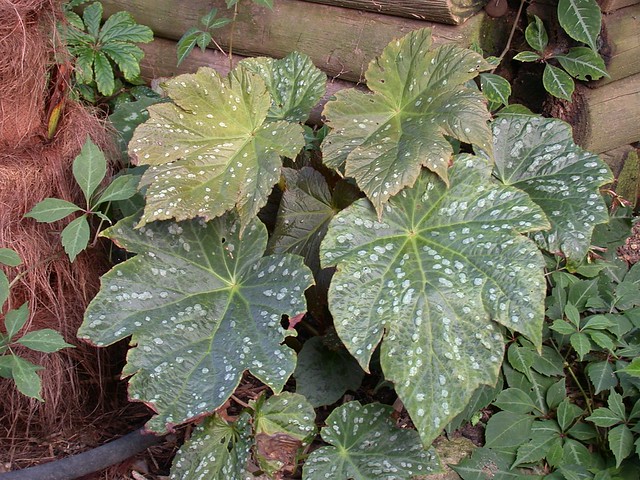
Begonia U475 in the garden
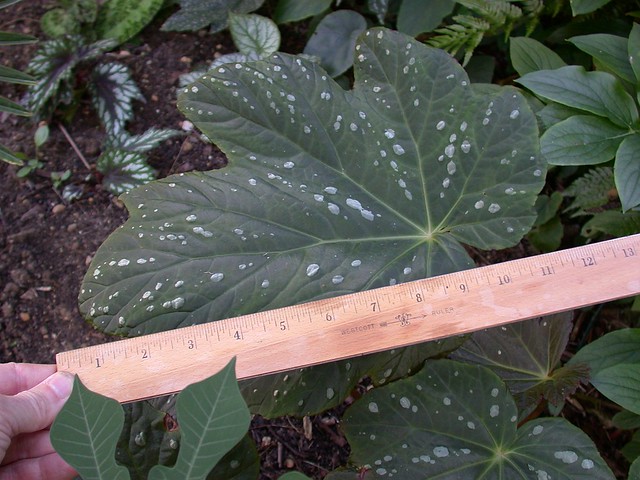
Begonia U475, leaf
Begonia deliciosa (2 winters, heavily mulched) has been in continuous cultivation for at least 80 years and never reported as hardy. Has nobody ever tried this plant in the ground anywhere with a cold winter? The growth habit is much like that of 'Little Brother Montgomery', with erect stems produced from a short underground rhizome but growing a bit taller, to about 2 feet (0.6 m) tall in my garden. It's late to come back in the spring but its ornamental foliage makes it worth the wait. B. deliciosa is often compared to the somewhat similar species B. diadema but I've found it much easier to grow. This species has been a parent of numerous hybrids (for example, see 'Charles Jaros' and 'Taconite' below) and all of these are probably worth testing for hardiness.

Begonia deliciosa grown indoors
Begonia 'Charles Jaros' (2 winters, heavily mulched) is another one that has been around for a long time without ever being suggested as hardy. Begonia breeder Paul Lowe registered this hybrid between B. hatacoa and B. deliciosa in 1980, naming it after longtime ABS member (and past president)--who else--Charles Jaros. The hybrid has a strong influence of B. deliciosa and is similar in general growth habit but with smaller leaves that are a lighter and brighter green. Despite the hard winter and coming up late, both 'Charles Jaros' and B. deliciosa grew bigger this year than last year. Establishment matters... and protection doesn't hurt.

Begonia 'Charles Jaros' (immature plant)

B. 'Charles Jaros' (left) with B. deliciosa (right)
Begonia 'Caribbean Star' (2 winters, heavily mulched) is a recent introduction from Palm Hammock Orchid Estate in Miami, Florida. I've been so impressed with this Tim Anderson hybrid that I devoted a blog post to it last year (see A sensational new begonia). The large gray-green leaves are heavily marked with silver, making this plant a standout in a shady location. The leaves are deeply lobed, adding to its exotic look. It can take quite a bit of light, probably even a bit of sun, but the leaves seem to grow larger in full shade. Pale pink flowers are produced very late in the growing season. This is one of the few begonias I've mulched heavily, and only because it grows next to my hardy banana (Musa basjoo). This competition for water and nutrients probably works against it, as my plant was a bit smaller this year than last year.
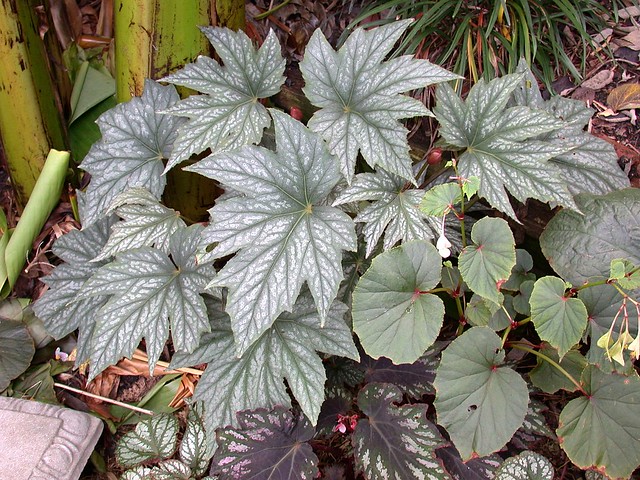
Begonia 'Caribbean Star' (October 2013)

Begonia 'Caribbean Star' in trial beds at Plant Delights Nursery
Begonia U508 (2 winters, heavily mulched) is a fantastic new begonia. Like 'Caribbean Star', I picked up this plant at Palm Hammock on nothing more than a hunch, simply because I liked its dark foliage. According to the ABS "U" listings it came from a botanical garden in Malaysia, but beyond that its origin is unknown. It doesn't resemble any Malaysian species and almost certainly comes from elsewhere in Asia. The plant produces upright stems from a rhizome at or below the soil surface; the leaves are very large, up to 15 inches (38 cm) long, and dark bronzy green with deep red undersides, developing a metallic purple sheen in high light. This plant tolerates heat well and can grow quite large in Florida. In my own garden, where it dies to the ground in winter, it only grows to about 18 inches (46 cm) tall but the large foliage more than makes up for any lack of height! The small pink flowers tend to hide under the leaves but U508 is well worth growing for its handsome, tropical-looking foliage. U508 has phenomenal potential as breeding stock. (The only U508 hybrid I've tried, 'Oteka', didn't survive even a mild winter in the ground but was planted very late in the growing season immediately before a very cold winter, so it wasn't really a fair test.)
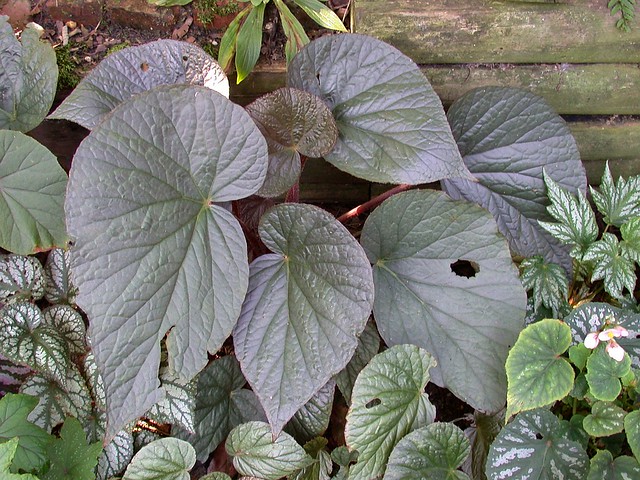
Begonia U508
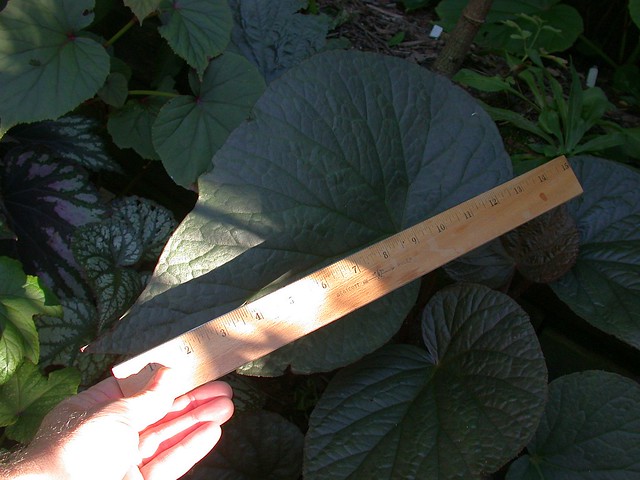
Begonia U508, leaf

Begonia U508, leaf underside
Begonia 'Taconite' (2 winters) is another Tim Anderson hybrid from Palm Hammock Orchid Estate. This was sent as a "bonus" plant by one of my ABS friends, who thought I might like it... and I do! 'Taconite' has large, very dark leaves with deep purple-red undersides. The leaves are somewhat variable in color, depending on cultural conditions like light and temperature, and under the right conditions have a faint silvery spotting that hints at its B. deliciosa parentage. Tim's begonia hybrids have been bred specifically for heat tolerance, but some of them are turning out to be surprisingly hardy as well. I believe this is because he used B. diadema and/or B. deliciosa in the parentage of many of them. Although primarily a foliage plant, the large pink flowers are held above the leaves and contrast nicely with the dark foliage.
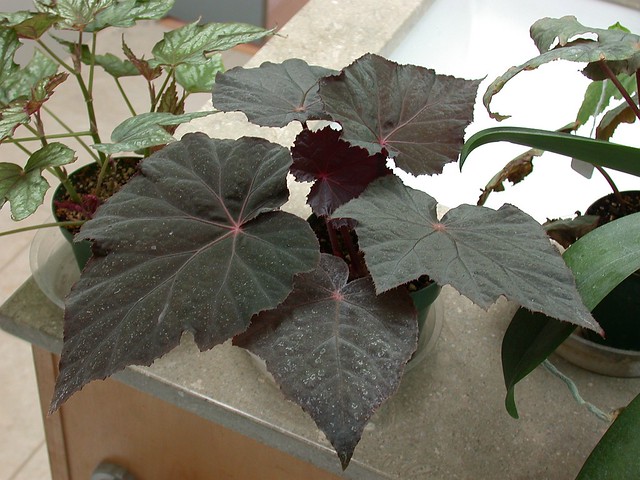
Begonia 'Taconite' grown indoors
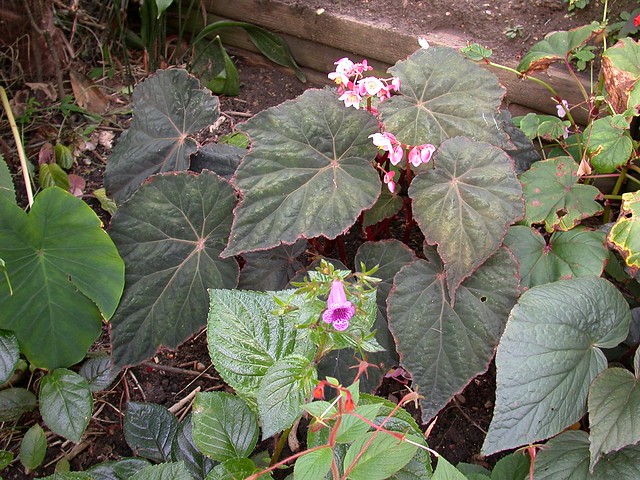
Begonia 'Taconite' in the garden

B. 'Taconite' flowers
Begonia 'Helen Teupel' (2 winters, heavily mulched) is an old rex hybrid, produced in the early 20th century by German begonia breeder Karl Teupel. I picked up this one as an impulse purchase at a plant society convention several years ago. I grew it as a house plant for a couple of years and when I planted it out in the garden, it was really just to get it out of the house to make room for other plants! I had no idea it would turn out to be hardy, but it came back strong after its first winter in the ground, albeit a warm one and with a heavy mulch; the real surprise was that it came back again this spring, although not as strongly. Under ideal conditions the leaves can grow quite large, and the foliage is quite a bit flashier than most of the other begonias I've tried. As with so many rex hybrids, the color and pattern vary quite a bit depending on cultural conditions like light and temperature. I have to wonder how many other rex hybrids that have been around for decades might be hardy but have never been tested?
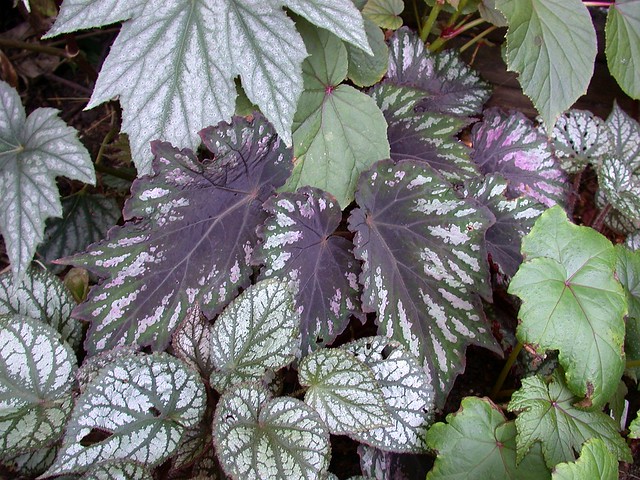
Begonia 'Helen Teupel'
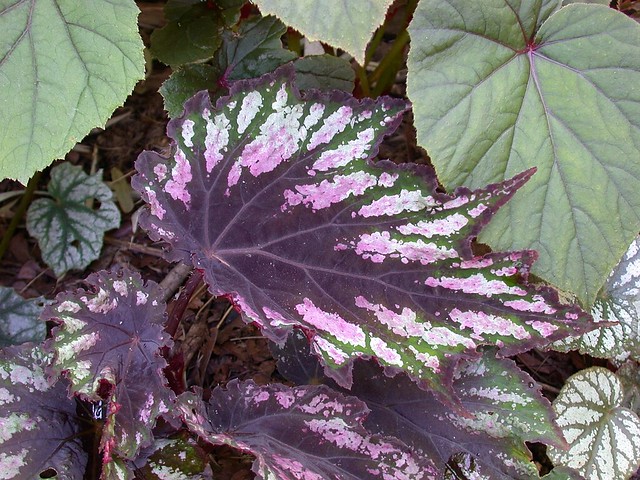
Begonia 'Helen Teupel'
Begonia "taiwaniana" (2 winters) is in quotation marks because the plant going around under this name is misidentified but I'm not quite sure what to call it. This plant has been around for a while, having been grown in the 1980's by ABS legend Millie Thompson from seeds sent from Taiwan as B. taiwaniana. I believe it may be the related species B. lukuana (previously confused with B. taiwaniana and formally described only in 1982), or it may be a hybrid; my plants haven't yet bloomed to allow me to narrow down an identification. The plant produces an erect stem with large, very attractive leaves that can vary quite a bit in color and pattern. This is probably the least hardy of the plants I'm listing here; my plant came back very late and rather weakly this spring.

Begonia "taiwaniana"
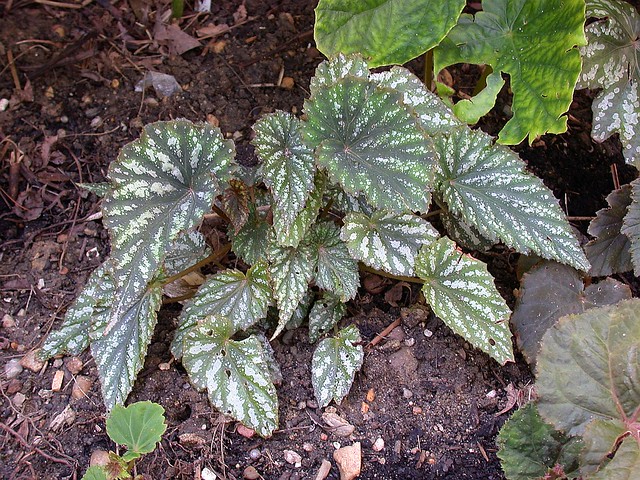
Begonia "taiwaniana" (June 2013)
Begonia sp. DJHT 99167 (2 winters) is a still-unidentified Dan Hinkley collection from northern Taiwan. Even with precise locality information provided by Dan, I've been unable to identify it; it's somewhat similar to B. chitoensis, but with much narrower leaves, and may be a natural hybrid between that species and B. longifolia, both of which are widespread in Taiwan and occur in the same general area. The begonia species of Taiwan are interesting and somewhat confusing, most of them probably originating as natural hybrids between a relatively small number of original species. An open-pollinated (i.e., male parent unknown, possibly B. grandis) seedling grown by Ozzie Johnson is being sold as B. 'Smooch' by Plant Delights Nursery and is reported as hardy to zone 6a (!).
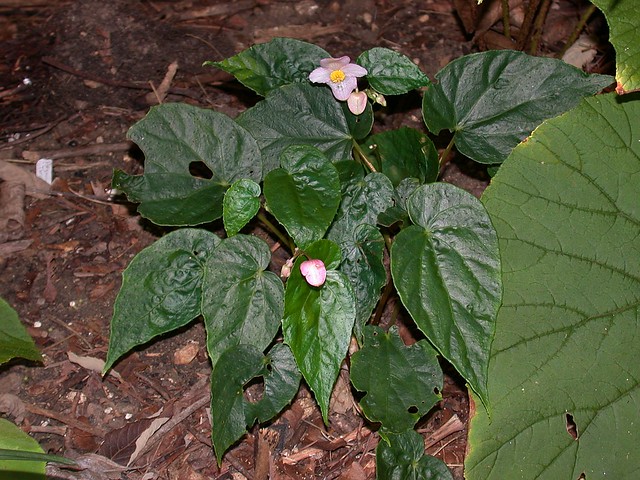
Begonia sp. DJHT 99167
Why am I having such good luck with "discovering" hardy begonias? I can't really claim any secrets with regard to overwintering, and I don't particularly pamper my plants because I've got that whole "lazy gardener" thing going on. I start with good-sized plants and get them in the ground early in the growing season, to give them a chance to establish themselves and develop good rhizomes and root systems well before winter. I've discovered that deep planting and mulch both go a long way towards winter survival; the plants will die to the ground, and then just wait out the cold weather. As long as the rhizomes don't freeze solid, they'll send up new growth in the spring. Depending on the winter, the new growth may come up rather late from deeply buried sections of rhizome so they need to be left undisturbed until late spring or early summer.
 Begonia 'Little Brother Montgomery' (upper left), B. pedatifida (center), B. U614 (right)
Begonia 'Little Brother Montgomery' (upper left), B. pedatifida (center), B. U614 (right)My biggest surprise is that some of these plants have been in cultivation for a very long time and never reported as hardy. Similarly, the gesneriad Titanotrichum oldhamii was in cultivation for well over a century before anybody discovered that it's quite hardy; it was treated as a tender plant because it came from subtropical Taiwan and southern China where it never experiences particularly cold temperatures. I also discovered, quite by accident, that the Vietnamese gesneriad Raphiocarpus petelotii is remarkably hardy. Perhaps these species once had more northerly ranges, pushed south during the last ice age, or perhaps their natural dormancy simply predisposes them to winter survival. Perhaps that's what is going on with some of the Asian begonias as well. The lesson for me is that while a plant's origin may hint at its hardiness, you don't really know what's hardy until you try. Don't be afraid to leave those plants out in the garden over the winter! Throw some mulch on them and step back. How many other plants are already in cultivation whose hardiness we simply haven't discovered yet?
Many thanks to Tony Avent, Dan Hinkley, and Ozzie Johnson for providing valuable information for this article!

Very impressive and informative post John, another one that I bookmarked for reference! Hopefully some of these will eventually make it across the pond for us to try here :)
ReplyDeleteWhy are they all Asian? Nearly all of mine are from the Americas...but I'm more focused on drought tolerance. Although I do have a nice basket of Begonia elaeagnifolia that I'm somewhat nervous about. Picked it up last fall from Kartuz. I was pretty sure that it wasn't going to make it outside but I couldn't resist such a neat trailing species. Put it in a basket and kept it outside during winter...but in a bucket covered in plastic. Took it out this spring and it's done quite well. Now I'm seriously considering putting it back in the bucket! Heh. I should have established some "insurance" cuttings earlier.
ReplyDeleteFor a while now I've been sitting on a blog entry that would compare a map of the distribution of epiphytic orchids with a map of wind directions. I suppose it's somewhat obvious that the two are correlated. North Asia seems to have the largest/longest land corridor leading out of the tropics. Africa can't go any further south and the north has a giant desert "hazard". South America has winds blowing north out of the Antarctic and North America has a desert hazard on the west and an ocean hazard on the east. Begonias, being mainly disseminated by the wind, have somewhat the same issue as orchids. But with terrestrial species there's a greater chance of exceptional winds blowing seeds onto suitable substrates.
Geography seems to work against the natural proliferation of hardy tropicals. I certainly would have arranged the continents differently...heh.
I do see a 'Little Brother Montgomery' in my future.
ReplyDeleteGreat info John!
ReplyDeleteU508 is so far my top freeze resistant variety. Thanks so much!
Ditto. I will save as reference. I may be growing Begonias indoors that I could have left in the ground. Will definitely try some of these -- there is nothing like their bold foliage and infinitely varied, beautifully patterned leaves to liven up a shade planting.
ReplyDeleteWhat ever happened to your Trachy Bulgarian? Im hoping to start a Rhapidophylum Histrix needle palm & so called Takils (community in the protected areas os Newark's microclimate as well as the north-southwest oriented Watchung hills of Newark. (South Mountain and Eagle Rock Reservations) The cliffs provide west wind protection-I hope. As for your Bulgaria I hope it didn't push a leaf and die like others you showed. Your silence is not a good sign.......If it dies in DC,Im not wasting time and money in New Jersey!
ReplyDeleteOf course I didn't mean that last sentence. I already have orders for Bulgarians planned. I also have trachycarpus takil (supposedly) seeds in ziplock baggie method. I now wish I had planted my 3 needle palms in Branch Brook Park due to this mild El niño winter. Its January 2 and its 40°f 8pm. They are calling for rain and 60°f in NYC/Newark on Sunday the 4th!
DeleteLet's bookmark this page for next year when we go begonia shopping.
ReplyDeleteRay
I have B. U475 well-mulched with a plant in the above-freezing garage for insurance.
ReplyDeleteOteka was originated by my mother-in-law and named after my daughter. It's a beautiful begonia, and I hope you can have better success with it going forward.
ReplyDelete